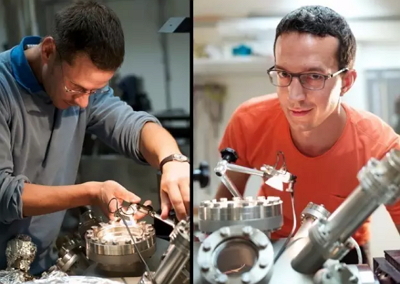|
管理员

|
逆天了!科学家们造出了久违的三角形分子
2月14日,《自然》子刊《Nature Nanotechnology》上刊登了一则让人不可思议的报道——来自IBM的科学家们造出了一款三角形分子,一偿化学家们近70年的夙愿。 导读 
2月14日,《自然》子刊《Nature Nanotechnology》上刊登了一则让人不可思议的报道——来自IBM的科学家们造出了一款三角形分子,一偿化学家们近70年的夙愿。 早在1950年,捷克有机化学家Erich Clar教授就预言了三角形化合物“triangulene”的存在。在他的设想中,这种分子由6个苯环融合而成。然而包括Clar教授在内,后续的合成尝试均以失败告终。科学家们发现,这个结构中的两个碳原子会带有未配对的电子,这些电子会急于和周围的物质发生反应,破坏三角形的结构。因此,这个三角形分子一直被视作化学合成中的难点。 “你一合成它,它就会氧化。”本项研究的第一作者,IBM团队的Niko Pavliček博士说道。 
▲Triangulene是合成的难点(图片来源:《Nature Nanotechnology》) 既然从头合成上有困难,我们为什么不反其道而行之呢?想到这一点的Pavliček博士与本项研究的主要负责人Leo Gross博士一道,做了一种全新的尝试。首先,他们拜托化学家们合成了前体化合物“dihydrotriangulene”。与triangulene相比,这个化合物带有额外的两个氢原子,能与triangulene上的两个未配对电子结合,形成稳定结构。 然而,研究人员们将这个分子放在了一种特殊的显微镜下。这种显微镜有根为这个实验量身打造的针头,兼具“扫描隧道显微镜”与“原子力显微镜”探针的特点。利用这根针头,研究人员“抠”掉了两个多余的氢原子,让triangulene的结果得以呈现。  ▲本项研究的通讯作者Leo Gross博士(左)与第一作者Niko Pavliček博士(右)(图片来源:《自然》)
有趣的是,通过这种方法得到的triangulene要稳定得多。至少,研究人员有足够的时间为它照上一张相。 “据我所知,这是人类第一次合成未取代的triangulene。”大阪市立大学(Osaka City University)的工位武治教授评论说。 除了验证Clar教授的预言外,这项发现还有着实际应用价值。正如研究人员所料,triangulene两个未配对电子的自旋相互匹配(aligned spins)。这一量子力学的特性有望让triangulene在量子计算,量子信息处理和自旋电子学等领域得到应用。 Gross博士指出,目前IBM的量子计算机只需要少数几个量子比特,每一个比特对应单独一个分子。如果能手动做出100个这样的分子,就会非常有价值。 参考资料: [1] Elusive triangulene created by moving atoms one at a time [2] Scientists synthesize long-sought triangle-shaped molecule [3] Synthesis and characterization of triangulene文献检索:doi:10.1038/nnano.2016.305 Triangulene, the smallest triplet-ground-state polybenzenoid (also known as Clar's hydrocarbon), has been an enigmatic molecule ever since its existence was first hypothesized1. Despite containing an even number of carbons (22, in six fused benzene rings), it is not possible to draw Kekulé-style resonant structures for the whole molecule: any attempt results in two unpaired valence electrons2. Synthesis and characterization of unsubstituted triangulene has not been achieved because of its extreme reactivity1, although the addition of substituents has allowed the stabilization and synthesis of the triangulene core3, 4 and verification of the triplet ground state via electron paramagnetic resonance measurements5. Here we show the on-surface generation of unsubstituted triangulene that consists of six fused benzene rings. The tip of a combined scanning tunnelling and atomic force microscope (STM/AFM) was used to dehydrogenate precursor molecules. STM measurements in combination with density functional theory (DFT) calculations confirmed that triangulene keeps its free-molecule properties on the surface, whereas AFM measurements resolved its planar, threefold symmetric molecular structure. The unique topology of such non-Kekulé hydrocarbons results in open-shell π-conjugated graphene fragments6 that give rise to high-spin ground states, potentially useful in organic spintronic devices7, 8. Our generation method renders manifold experiments possible to investigate triangulene and related open-shell fragments at the single-molecule level. http://www.nature.com/nnano/journal/v12/n4/full/nnano.2016.305.html 2017/02/15 来源:药明康德 逆天了!科学家们造出了久违的三角形分子 http://www.biodiscover.com/news/research/653268.html |
|
管理员

|
沙发#
发布于:2017-04-09 20:11
Synthesis and characterization of triangulene
Nature Nanotechnology 12, 308–311 Rights & permissions |

 一键同布到我集网·各家微博
一键同布到我集网·各家微博